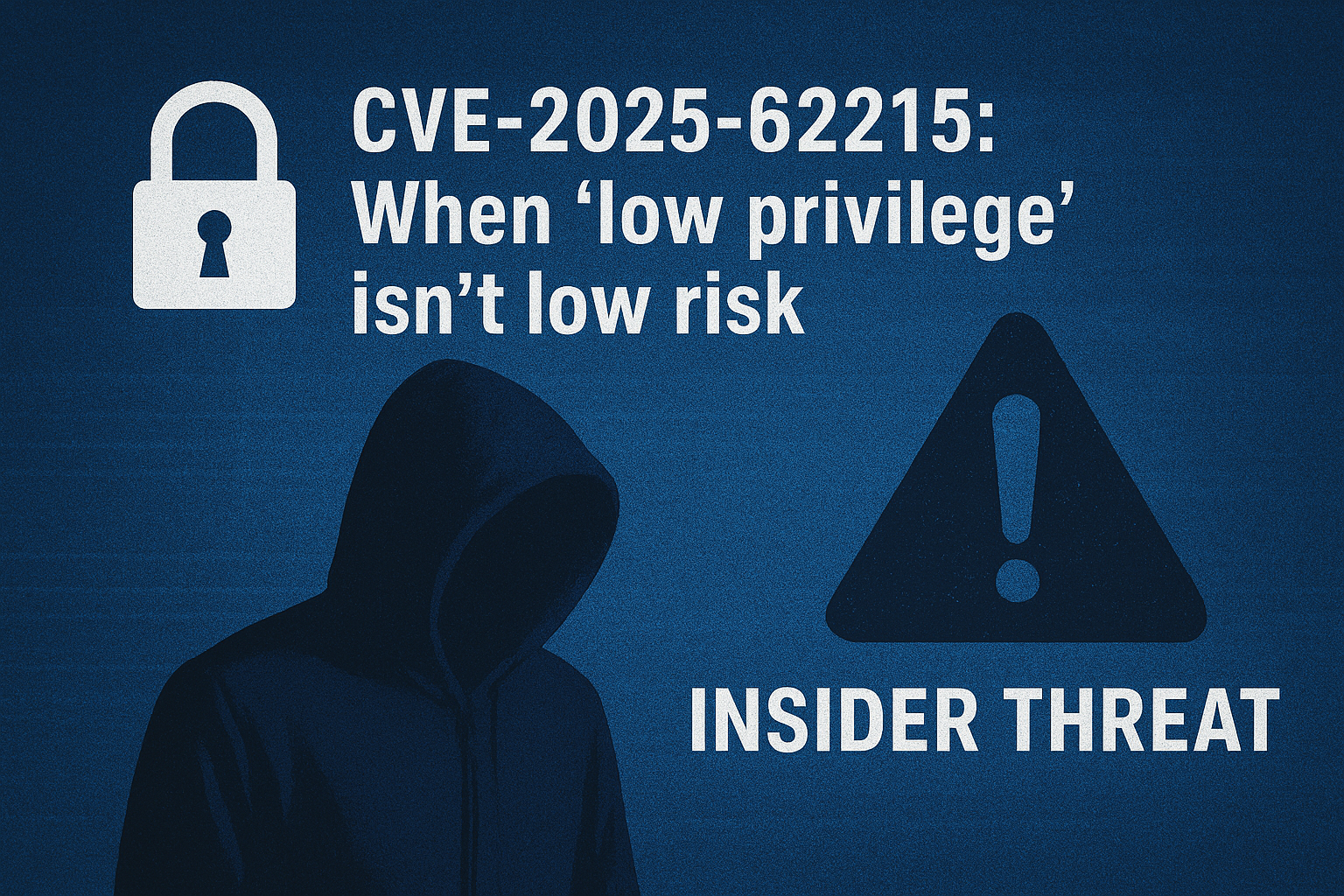When most organizations think about insider threats, they imagine disgruntled employees stealing data or misusing privileged accounts. But insider risk is often more subtle. Sometimes the most dangerous insider is the one with very limited access who knows how to exploit a flaw that others overlook. CVE-2025-62215, disclosed and patched in November 2025, is a perfect example. It is a Windows Kernel elevation-of-privilege vulnerability that allows an authenticated local attacker with low privileges to escalate all the way to SYSTEM. No user interaction is required. For an insider threat actor, this is a golden opportunity.
How an Insider Could Exploit CVE-2025-62215
The vulnerability arises from a race condition combined with a double free memory corruption in the Windows Kernel. A race condition occurs when multiple threads access shared resources without proper synchronization. If an attacker manipulates timing, they can cause the system to behave in unintended ways. In this case, the race condition leads to a double-free, which corrupts the kernel heap and enables arbitrary memory overwrite. Once the attacker controls memory in the kernel, they can escalate privileges to SYSTEM.
For an insider, the exploitation path is straightforward:
- Local access is enough. The insider does not need administrator rights. A standard user account is sufficient.
- No user interaction is required. The insider does not need to trick anyone into clicking a link or opening a file.
- SYSTEM privileges are the prize. Once exploited, the insider can dump credentials, disable endpoint defenses, and move laterally across the network.
This makes CVE-2025-62215 particularly dangerous in environments where insiders already have accounts but are restricted in what they can do. It also makes it useful for attackers who compromise service accounts or other low-level credentials.
Why Insider Threat Actors Love This Flaw
Insider threat actors thrive on opportunity. They often know the systems, processes, and defenses better than external attackers. CVE-2025-62215 gives them exactly what they need:
- Stealth. Because no user interaction is required, exploitation can be quiet and difficult to detect.
- Speed. Once SYSTEM privileges are obtained, the insider can quickly disable monitoring tools or exfiltrate sensitive data.
- Leverage. SYSTEM access allows the insider to pivot into other accounts, escalate privileges further, and compromise domain controllers.
In short, this vulnerability turns a low-level insider into a high-level threat overnight.
Mitigation Strategies
The good news is that CVE-2025-62215 was patched in Microsoft’s November 2025 Patch Tuesday release. But patching alone is not enough. Organizations should take a layered approach to mitigate insider exploitation.
1. Patch Immediately
- Apply the November 2025 updates across all supported versions of Windows, including Windows 10 1809, 21H2, 22H2, and Windows 11 23H2.
- Map CVE-2025-62215 to the appropriate KB articles and verify deployment across all systems.
2. Harden Accounts
- Enforce least privilege. Limit what standard users and service accounts can do.
- Rotate and monitor service account credentials.
- Use just-in-time access for administrative accounts.
3. Enable Kernel Exploit Mitigations
- Turn on Hypervisor-protected Code Integrity (HVCI).
- Use Device Guard to restrict what code can run in the kernel.
4. Monitor for Exploitation Attempts
- Deploy endpoint detection tools that can identify race condition exploitation attempts.
- Look for unusual thread activity or memory corruption indicators.
- Monitor for privilege escalation events that do not align with normal workflows.
5. Build Insider Threat Programs
- Combine technical controls with behavioral monitoring.
- Train employees on acceptable use and reporting suspicious activity.
- Use data loss prevention tools to detect exfiltration attempts.
Strategic Implications
Race conditions are complex to exploit, but attackers are increasingly automating them. That means flaws like CVE-2025-62215 can be weaponized quickly. They are also highly valuable when chained with remote code execution or sandbox escape vulnerabilities. In those scenarios, an insider could move from low-level access to full SYSTEM control in one chain. For defenders, this underscores the importance of rapid patching and layered defenses. Insider risk is not just about malicious intent. It is also about technical opportunity. A low-level insider with knowledge of a flaw like this can become a high-level threat overnight.
Conclusion
CVE-2025-62215 is a reminder that insider threats are not always about intent. Sometimes they are about opportunity. This Windows Kernel race condition allows insiders with low privileges to gain SYSTEM control without any user interaction. Organizations should patch immediately, enforce least privilege, enable kernel exploit mitigations, and monitor for exploitation attempts. Insider risk is not just about who you trust. It is about what the system allows them to do when flaws like this exist.
Sources
- Microsoft Security Response Center, November 2025 Patch Tuesday advisories
- Cybersecurity and Infrastructure Security Agency, Known Exploited Vulnerabilities Catalog






Leave a Reply